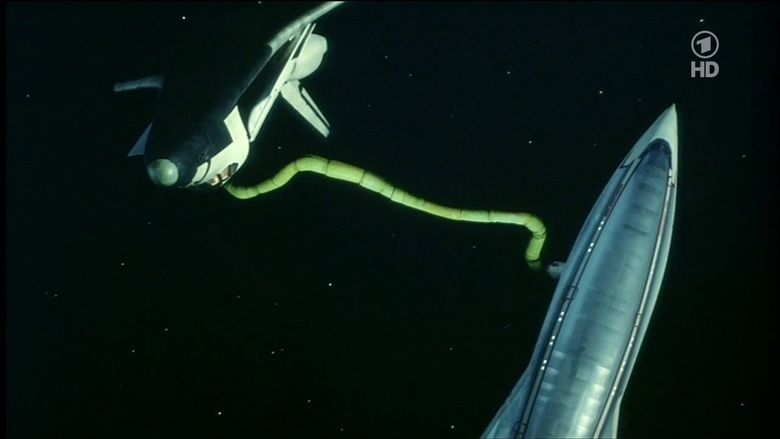
One is giving birth to the other. Except it’s about to explode in fire! In space! Oh, the humanity!
Starflight: The Plane That Couldn’t Land (aka Starflight One or Airport 85; 1985) is a limp noodle of a movie. Thematically, a story concerning the tension between free enterprise and good engineering, it’s about a hypersonic jet on its maiden commercial voyage. A simulator seems to suggest it may have problems at its operational altitude of 100,000 ft, but the mean old boss of the manufacturer refuses to be cautious.
And then a rocket is recklessly launched in Australia on the orders of a businessman set to make or lose a lot of money, without coordinating with NASA, against the better judgment of the flight manager. When the jet is reaching the pinnacle of its flight (we never actually see the takeoff, at least in this TV version of the movie – oh, wait, this is a made-for-TV movie!), the rocket malfunctions and must be destroyed, spraying debris in the flight path of the jet.
Yep, it gets hit.
And we don’t care. No story succeeds when we don’t care. Look, you don’t have to like anyone – after all, care doesn’t mean rooting for, it can also mean having a hate-on. But when a movie, a story, has characters who elicit nothing more than a shrug and a sickly joke about who’s sleeping with whom?, then your story has a problem.
A big problem.
It’s a fucking black hole of a problem.
So never mind that the science had us laughing out loud at points. Never mind the continuity problem when they call the second spaceship coming to their rescue by the name of the first one. Never mind that at one point they say they don’t have enough oxygen to make it to re-entry, and then do so anyways. Never mind that the children are not the first ones to be saved. Never mind that the journalist / volunteers who stay behind to face certain death, just on the off chance that the pics could be great if they survive, are never seen snapping a single pic.
We have no idea why we should care about anyone. Well, except hating a couple of type-A businessmen, and that just isn’t enough.
Sure, there’s interpersonal relationships – or so we’re told. Hell, it’s a little like watching a bunch of Swedes on Valium, for all the emotion we get out of this bunch.
Anyways. Deep breath. Stay away from the Bold and Italic buttons.
Just Don’t Watch This Film.










 Trump’s appointees, by and large, are non-existent or incompetent. The main driver of an effort like this would be the Secretary of State, but by all accounts the current occupant of the position, Rex Tillerson, is ignorant of the powers of his position, and really quite somnolent.
Trump’s appointees, by and large, are non-existent or incompetent. The main driver of an effort like this would be the Secretary of State, but by all accounts the current occupant of the position, Rex Tillerson, is ignorant of the powers of his position, and really quite somnolent.
